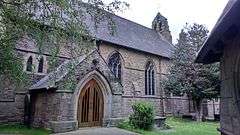Tinsley, South Yorkshire
Tinsley is a suburb of northeastern Sheffield, South Yorkshire, England. The suburb falls within the Darnall ward of the City.
| Tinsley | |
|---|---|
 Church of St Lawrence | |
 Tinsley Location within Sheffield | |
| OS grid reference | SK395907 |
| Metropolitan borough |
|
| Metropolitan county | |
| Region | |
| Country | England |
| Sovereign state | United Kingdom |
| Post town | SHEFFIELD |
| Postcode district | S9 |
| Dialling code | 0114 |
| Police | South Yorkshire |
| Fire | South Yorkshire |
| Ambulance | Yorkshire |
| UK Parliament | |
The name "Tinsley" is also associated with the nearby former Tinsley Marshalling Yard and the Tinsley Viaduct, which carries the M1 motorway across the Don Valley, as well as the former Tinsley Towers.
History
The name of the suburb derives from the Old English Tingas-Leah, which means 'Field of Council', cognate with "thing (assembly)" and "lea", a dialectal word for "meadow". It is mentioned as 'Tirneslawe' or 'Tineslawe' in the Domesday Book of 1086 when it was in the possession of Roger de Busli.
The chapel of St Lawrence, Tinsley was built in 1877 on the site of an ancient (possibly of Anglo-Saxon origin) chapel.[1] An annual royal payment was received until 1847 in order that a service for the dead could be held.[2]
Another tradition associated with the settlement required the Lord of the Manor of Tinsley to take a pair of white gloves to the Lord of Tickhill each year at Michaelmas, and receive in return a white dove to keep over winter.[2]
Tinsley Wood lay to the south of the settlement, on land now partly occupied by Sheffield City Airport and High Hazels Park. It may have been the site of the Battle of Brunanburh in 937, where Athelstan of Wessex gained the submission of the Celtic monarchs of Norse-Ireland & around Britain.[2] In the mediaeval period, it was associated with outlaws, one named as "Roger de Presteman, an outlawe of Tyneslawe".[3]
The area became industrialised from 1732, when the River Don Navigation was extended to terminate in the village. A turnpike road was constructed to Sheffield. In 1819, the Sheffield Canal was opened, running from Tinsley to Sheffield. The area became major industrial centre known for its collieries, iron, steel, and wire works.[3]
Companies such as George Cohen, the '600 works', Osbourn Hadfield and Brinsworth Strip Mills were occupants of the landscape near Tinsley and the neighbouring district of Templeborough. Only the BOC plant and Brinsworth Strip Mills remain within the village boundaries. All the remaining works were either demolished or preserved as a museum to what was the heart of Sheffield industry until 1985.
Facilities and attractions
Replacing the steelworks on Vulcan Road is the Meadowhall shopping centre.
In the centre of Tinsley is the Tinsley Recreation ground (sometimes referred to as "the Rec"). Recently, part of this has been claimed as a community centre called Tinsley Green. It has a new 5-aside football pitch, Tennis court, children's playground, adult rides and a cricket bowling practice area.
From 1997 to 2008 the area was home to the Sheffield City Airport, a small airport which offered mostly business-orientated flights to domestic locations in the UK and select cities in Western Europe. The airport closed to commercial traffic amidst controversy in 2002 and permanently in 2008 when its CAA Licence was withdrawn. The site remains mostly derelict despite plans having been approved for the construction of a business park on the old runway, and rumours of bids and petitions to re-open the airport regularly circulate.
The area around the old airport site and Shepcote Lane area houses several industrial units and modern business complexes.
References
- Wood, Michael (2001). Tinsley Wood. In Search of England: Journeys into the English past, pp. 203–221. Penguin Books Ltd (University of California Press in the United States). ISBN 0-520-23218-6
- Tinsley Park Wood
- J. Edward Vickers, "The Ancient Suburbs of Sheffield", pp.11–12 (1971)